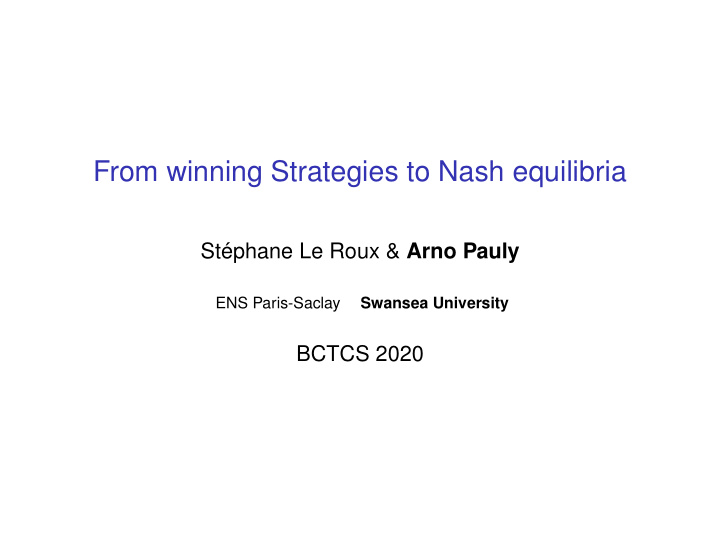



From winning Strategies to Nash equilibria Stéphane Le Roux & Arno Pauly ENS Paris-Saclay Swansea University BCTCS 2020
Introduction ◮ Games played on finite graphs are of great interest (recall Patrick Totzke’s talk) ◮ Usually, people care about winning strategies realizable by finite automata. ◮ We want to generalize to multiplayer multioutcome games. ◮ We then care about finite memory Nash equilibria. Question Under what conditions can we obtain the existence finite memory Nash equilibria in the multiplayer multioutcome version of a game from the existence of finite memory winning strategies in the two-player win/lose version?
Games played on graphs a a start b b
Preferences ◮ Vertices are labelled by colours c ∈ C . ◮ Players now have preferences ≺ a over C ω . ◮ A Nash equilibrium is an assignment of strategies to players where no player can do better by changing their own strategy.
The notions for our result ◮ A strategy is optimal, if it guarantees the best worst-case . ◮ A preference has the optimality is regular property, if for any game and any finite memory strategy there is a finite automaton deciding whether the strategy is optimal from some history onwards. ◮ A preference ≺ is prefix-linear, if p ≺ q ⇔ hp ≺ hq for any finite history h ∈ C ∗ and infinite histories p , q ∈ C ∗ . ◮ Being (automatic-piecewise) prefix-linear implies optimality-is-regular.
The notions for our result II ◮ A threshold game is derived win/lose game based on some outcome: One player wins, if he can do better than that, otherwise everyone else wins. ◮ Future threshold games start with some history. ◮ Uniformly finite memory means that the required memory depends only on the size of the game graph, not on the history.
The result Theorem Let ( ≺ a ) a ∈ A be closed under antagonism. The statements below refer to all the games built with C, A, and ( ≺ a ) a ∈ A . FTG-ufmd ∧ OIR ◮ OIR: Optimality is regular. 1 ◮ fm-SOS: There are finite-memory subgame-optimal strategies. ◮ fm-NE: There are finite-memory Nash FTG-d ∧ fm-SOS equilibrium. ◮ FTG-d: The future threshold games are determined. 2 3 ◮ TG-ufmd In every game, the FTG-ufmd fm-NE threshold games are determined using uniformly finite memory. 4 5 ◮ FTG-ufmd: In every game, the future threshold games are determined using uniformly finite memory. TG-ufmd
Strictness We know that Implications 1 and 2 do not reverse, but no more. Question Is there a preference ≺ such that all threshold games for ≺ are uniformly finite memory determined, but not all future threshold games?
Why talking about all graphs is needed Example (Based on ideas by Axel Haddad and Thomas Brihaye) start c1 b1 c2 b2 Figure: The graph for the game in Example 2 The game g in Figure 1 involves Player 1 (2) who owns the circle (box) vertices. Who owns the diamond is irrelevant. The payoff for Player 1 (2) is the number of visits to a box (circle) vertex, if this number is finite, and is − 1 otherwise.
The paper Stéphane Le Roux & Arno Pauly: Extending finite-memory determinacy to multi-player games. Information & Computation. Vol 261 (2018)
Preceding work T. Brihaye, J. De Pril, S. Schewe: Multiplayer cost games with simple Nash equilibria Logical Foundations of Computer Science. (2013)
Further reading Stéphane Le Roux, Arno Pauly & Mickael Randour: Extending Finite-Memory Determinacy by Boolean Combination of Winning Conditions. FCT&TCS 2018
Recommend
More recommend